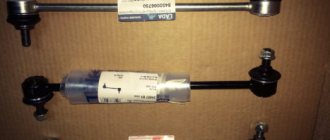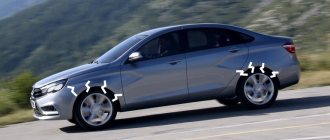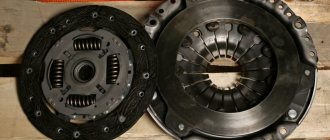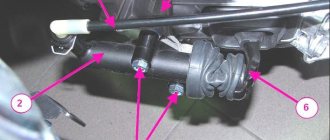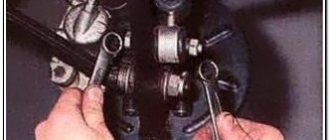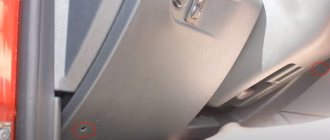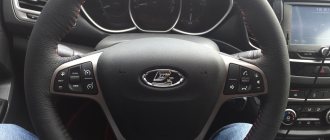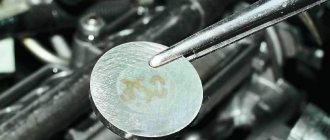Suspension creaks on bumps in front
The front and rear suspension of Vesta differs significantly from the one that AvtoVAZ used on Grant, Priora, Kalina, etc. All the reviews tell us that the new chassis design is better than before. However, during the first months of operation, the owners began to notice extraneous noises (knocks, creaks, rattles, crunches) in the front and rear suspensions of Vesta, which occur when driving over speed bumps or other road irregularities...Sequence of actions when replacing roll bar bushings
Catalog number - 8450006748, cost of original spare parts - from 350 rubles/piece. As an alternative, use polyurethane bushings from Chevrolet Niva (17012680).
Required tools:
- TORX 40 wrench, heads “13” and “16”;
- knob;
- extension wrench;
- torque wrench;
- new bushings, preferably polyurethane ones, as they have a longer service life.
Step-by-step instruction:
- We hang the front part of the car with a jack and use a hydraulic lifting mechanism.
- Unscrew the steering gear casing (head at “10”).
- We unscrew the steel brackets that secure the rubber bushings (the key is set to “13”).
- Unscrew the front bolts (T40 key) and remove the bushings.
- We insert new ones and assemble the structure in reverse order.
Tighten the bolts with a force of 2.0 kgf/m.
Front suspension problems
Significant defects in the front part of the Lada Vesta, which are accompanied by external noise:
1. Rumble in the stabilizer; 2. Knock on the right side of the ball joint; 3. The stabilizer struts are rattling.
All these problems are fixed at AvtoVAZ centers. When driving over an uneven surface, a dull knock appears as if rubber is rubbing. The muffler mount must be lubricated with grease.
In the front suspension of the Lada Vesta, a creaking noise may indicate wear on the struts. This defect can be eliminated by replacing with new ones.
Problems with noise and squeaking from the rear of the car
Creaking from the rear of the car Malfunctions can also manifest themselves as a knocking sound in the rear suspension when driving over uneven surfaces or a creaking noise from the rear.
All these sounds signal a problem that needs to be solved. In order to remove it, as recommended by the factory, it is necessary to cut out the gasket and install it on the upper shock absorber support. This will eliminate knocking in the Lada Vesta suspension. Poorly spun wheels can crunch and squeak. This often occurs on other car models and is caused by the car owner’s carelessness when changing wheels. It is urgent to stop and tighten the wheels.
Contacting the dealer and AvtoVAZ’s position
If you have decided to contact a Lada dealership, you will most likely be unpleasantly surprised. The fact is that the Russian automaker, although it recognized the problem, took the simplest path to solving the issue.
At the dealership, the bushings are lubricated with grease.
The craftsmen do not replace the bushings, but simply lubricate them with PMS 400 grease. To carry out lubrication work, the unit is disassembled and then reassembled. PMS 400 is an emulsion-based lubricant with adhesive properties. It is widely used in defoamers and in plastic-to-metal contact areas. It has hydraulic, shock-absorbing, cooling and damping properties.
The result of using this lubricant is twofold. The Vesta stabilizer bushings actually stop squeaking, but this does not last long. The reason is that the lubricant is quickly washed out (literally within 100-150 km) and the sounds are heard again. This moment is especially pronounced in the fall, during rainy weather.
Wear of stabilizer link joints
When diagnosing stabilizer bushings, as a rule, all elements of the front suspension are inspected and, first of all, the vertical struts of the anti-roll bar (article no. 8450006750), which also often fail in Lada Vesta.
Lada Vesta produces standard stabilizer bars. These parts are of fairly high quality, but they also have their own resource, which depends on many factors. The degree of wear of the vertical struts is determined by the presence of play in their hinges - if the struts knock when the stabilizer is suddenly manually moved, they need to be replaced. Knowing the length of the struts (283 mm), you can select even better parts for replacement, for example, from Toyota or Hyundai.
- socket wrench “16” - unscrewing the nut;
- Torx key 30 – pin locking.
Production of replacement racks
The work is carried out on a car lift. Replacing parts with new ones is not difficult: fix the finger with one key, and unscrew the nut with the second.
Which stabilizer struts should I choose for VAZ (Lada) Vesta?
Last month, PartReview users gave preference to Monroe. 20% of positive votes belong to this manufacturer.
In second place were the TRW stabilizer struts - 10%.
Lemforder closes the top three with 10% of the votes.
In the general rating of stabilizer struts, which takes into account the opinions of owners of different brands and models of cars, these brands occupy the following positions:
- Monroe received 6th place, PR score - 72. Data from 17 reviews and 54 votes are taken into account.
- TRW was ranked 18th with a PR score of 53. Based on 17 reviews and 62 votes.
- Lemforder is ranked 8th and has a PR score of 70. Data from 53 reviews and 172 votes are taken into account.
Knocks and noises in the front suspension
Even an amateur can recognize extraneous noises that appear in his own car, because an unfamiliar sound is always clearly audible against the background of the familiar “ensemble.” Knocks and noises in the chassis of the car should not plunge the owner into a state of shock, because all components are repairable, but it is necessary to urgently diagnose and fix problems, since the condition of the suspension is not only driving comfort, but also road safety.
Extraneous noise can be produced by rubber with a hard tread or with a broken cord. A wheel bearing that has become unusable has similar symptoms. During the off-season, the accumulated dirt that gets between the brake disc and pads disturbs the ears.
Knocks have a different nature and appear in different situations. The cause of such an unpleasant phenomenon may be a faulty stabilizer link or bushing, a failed ball joint or support bearing. Let us examine in detail the diagnostic methods and methods for troubleshooting the suspension of the Lada Vesta.
Wheel bearing noise
If an inexperienced driver does not notice such a malfunction immediately, then over time he will still have to think about diagnostics, since this noise increases all the time.
In particularly advanced cases, the whine of the bearing can be heard in the cabin and can drown out other sounds.
Diagnostics
In order to make sure that the bearing is faulty, and at the same time determine from which side the sound is coming, it is enough to accelerate on the highway to 50 km/h, make sure that there are no other road users in front or behind, and make oscillating movements of small amplitude with the steering wheel while steering the car then to the right, then to the left.
If the sound dies down in one position of the steering wheel, and intensifies in another, then it’s definitely a bearing. Moreover, an increase in sound when turning to the right indicates a malfunction of the left bearing and vice versa. All that remains is to verify the assumption. To do this, hang the wheel on which suspicion falls. When it rotates, a noise is heard - change the bearing.
How to identify a malfunction
Even during the release of the first batches of Vesta from the assembly line, buyers rightly noticed shortcomings in its work, which were corrected in subsequent batches. The sounds that the rear or front suspension can make are very varied - the design is very complex, consisting of many parts that can fail. However, the most common breakdowns among Lada Vesta owners stand out and are worth disassembling.
Rear crunching is a fairly old problem for West. The knock of the rear chassis is corrected according to a special instruction from AvtoVAZ, according to which the design will have to be slightly supplemented. Between the upper support and the rear shock absorber strut you need to place a washer with a length of 130 mm, a distance between the holes of 100 mm (hole radii - 5 mm), a base radius of 34 mm, and finally a radius of the main hole of 25 mm.
The crunch will disappear, but only if the washer matches the dimensions, otherwise a gap will appear between the body and the support, into which dirt gets trapped. The cause of concern due to crunching or knocking may also be:
- worn trunk lid damper;
- stretched handbrake cable (it can be pulled from the passenger compartment);
- trunk lock;
- rear sofa backrest fasteners.
And just in case, check the contents of the trunk itself - there may just be tools rattling around there.
- The first, most popular reason for calling for service is the thumping (knocking) sound of the front suspension of the Lada Vesta, which comes from the stabilizer. Typically occurs when driving over artificial bumps. Stabilizer bushings, unfortunately, are not suitable for long-term use; even lubricant will not help - the only way to treat them is by replacing them. To solve the problem, you can install polyurethane bushings from Niva Chevrolet, its number is 17-012-680.
- The second reason for knocking can be called play of the ball joint, when a large gap is created between the parts. Problems can be solved by changing the design with levers. A grinding noise can be heard due to wear on the stabilizer struts and can mean that the car is gradually “losing” confidence when cornering.
- The creaking of the front suspension is caused by the hinges of the stabilizer struts. While driving, a knocking noise may occur due to insufficient tightening of the wheel bolts. When such a sound is heard, it is better to contact a service station as quickly as possible to prevent parts from breaking.
- The reason why the suspension on the Lada Vesta rattles and creaks can be heard may be that one of the parts has worn down to a sufficient level and is now knocking against another. To notice damage in time, it is enough to periodically inspect your car. If something is rattling, the part can be identified by shaking the car.
- If crunching or knocking noises in the front suspension are heard infrequently, the cause most likely may be a torn steering rod oil seal. This oil seal is in very close contact with the subframe of the vehicle (the distance between them at rest is 1 cm), and they collide at every bump. The oil seal breaks, and the connection of the rod to the rack hits the subframe.
What creaks and knocks in the cabin
At the back, the rear shelf creaked where it touched the glass.
The plastic trim of the triangular window also creaked - I simply sealed all the fastening points. When I bought the Lada Vesta in 2021, I read a bunch of reviews about the first series of cars. There have been complaints about the seat belt retractors rattling in the rear and front. The owners removed the rear shelf, the plastic trim on the front, tightened it, and inserted additional washers.
I avoided this flaw, but it cannot be ruled out even on new machines. Handles and door cards may creak in front. There may also be squeaks behind the instrument panel. There may also be noise behind the multimedia system. Also, the glove compartment lid sometimes knocks, or the light switch limit switch is not pressed all the way.
There was an adhesive seal there, but it came off. The glove compartment body creaked, I glued it. The sun visors may rattle on uneven surfaces. The passenger one has not yet been replaced under warranty due to knocking on the trim. The central pad on the steering wheel also creaked. It was glued by the personal manager himself on his initiative. Now the steering wheel is new, replaced under warranty due to wear on the lower insert. There are no extraneous noises now.
The most common shortcomings of the Lada Vesta car suspension
Drivers' complaints are caused by extraneous noises, squeaks and crunching sounds from the car's chassis. Most often they occur in the front part of the car, but many also complain about knocking from the rear suspension elements. The most common causes of these sounds are:
- Noise from front stabilizer struts.
Owners of the first Vesta cars began to notice extraneous sounds from the front suspension after several thousand kilometers. The reason for this turned out to be poor-quality stabilizer links. After considering consumer complaints, the manufacturer ordered that these parts be replaced free of charge in case of complaints.
- Rear shock absorbers knocking.
The rear struts knock when driving on rough roads. This is due to the fact that there is no insulating gasket between the shock absorber and the upper support, and metal hits metal when hitting an obstacle. The official service does not undertake to eliminate this deficiency, since it does not affect the driving performance of the car.
Front suspension device
The design of the unit has changed noticeably. Even before repairing new Vests, technical centers had to be trained on the new model. The front suspension sits on a subframe, which was not seen on earlier VAZ models. As a result, the upper part above it (engine compartment, steering rack, etc.) received protection, and the lower part of the suspension received static fasteners. The steering rack, which is located above the subframe, is still located slightly lower than it was on previous models. This means that the steering linkage now works directly with the steering knuckle.
The steering shaft is supplemented with an electric power steering, which transmits the turning forces of the steering wheel to the wheels. The rack transmits force to the rods, and they work with the hubs - they allow you to control the movement of the wheels under control. The hub is also pressed against the disc brake, controlling the uniformity of its contact with the wheel.
The suspension itself is independent; on the Lada Vesta, the front mechanism levers are L-shaped. The right and left front suspension arms operate independently of each other. The transverse stabilizer has undergone modifications, which gave the car greater maneuverability, as well as better cornering control. Its struts are more like a sports car, they smooth out the effect of such maneuvers at speed.
Review of Manufacturer Prices
| Catalog number / Size / Diameter | Price in rubles |
| Original | |
| 17012680 (inner diameter 21.5 mm.) | From 400 |
| 8450006748 | From 400 |
| Analogs | |
| Polyurethane from Chevrolet Niva 2123 (17012680) | From 350 |
| Polyurethane for Lada Vesta from Kia Rio (548132K100, 548141G000) | From 550 |
| 54813-2K100 (diameter 21.5 mm.) | From 550 – 600 |
| KSBSOULF (diameter 21.5mm) – new sample | From 550 – 600 |
| Vesta front left / right (8450006750), stabilizer struts length 275 mm | From 700 |
| RENAULT Logan suspension mount (30768) | From 130 |
| Nut RENAULT 7703034221 | From 300 |
| Bracket 8450006747 | From 350 |
| Rod 8450006748 | From 450 |
| Toyota Rav4 (48820-42020), length 285 mm | From 2500 |
| CTR (CLT50) | From 650 / piece |
| Renault, SASIC, SIDEM, LEMFORDER, length 275 mm | From 400 |
| Alfa – Fiat – Lancia 46413122 | From 370 |
| MONROE: L15600 | From 380 |
| Multipla, Lybra | From 350 |
| Kia Rio (548132K100) | From 370 |
| Bracket (548141G000) | From 250 |
*prices are as of April 2, 2019.
Conclusion
If you notice a third-party creaking, knocking, or rattling noise in the suspension, don’t panic. Malfunctions are a natural process
At the initial stage, it is important to correctly identify the source of the breakdown and its location
If you do not have a special tool, such as mounting tools or TORX keys, contact a service station. It is extremely difficult to repair a car with your bare hands.
Regarding the manufacturer of spare parts, the final decision rests with the owner of the technical equipment. The domestic manufacturer is not inferior in quality to foreign analogues. In this case, it is not advisable to overpay for the brand.
Video about defeating squeaking noise in the Lada Vesta suspension
In addition to these factors, time plays a decisive role.
If the service life of some units has come to an end, then they need to be replaced urgently, since one breakdown can lead to others, and the entire mechanism will go into disarray.
If we return a little to squeaks, then with significant fatigue of the ball joints, steering tip and rack, failure of the shock absorber, or its broken supports, unnatural irritating sounds may appear. Then it is best to go for a diagnosis and then treat the problem.
